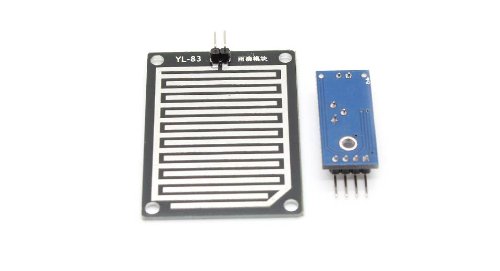How to protect rain sensor from oxidation?
-
Hi Marcel
Is it oxidation or electrolysis? Some of the sensor use DC to detect rain which can cause electrolysis.
Markus
-
Hi,
I have a rain sensor like this:

How can I protect this as I am currently every 6-8 weeks need to replace it :(
Thanks for suggestions!
Marcel
@martim
Instead of measuring resistive with contact to water, consider measuring contactless to water by for instance using a inductive or capacitive measuring method. The closest that aproaches your current sensor is a capacitive soil sensor (example: [https://www.dfrobot.com/wiki/index.php/Capacitive_Soil_Moisture_Sensor_SKU:SEN0193]) which I guess should also work to measure rain.
Of course you should seal the top part of the pcb with the electric components from rain.
But with some imagination and ingenuity you should be able to come up with different solutions. -
Hi Marcel
Is it oxidation or electrolysis? Some of the sensor use DC to detect rain which can cause electrolysis.
Markus
@fotofieber I have no idear.
-
@martim
Instead of measuring resistive with contact to water, consider measuring contactless to water by for instance using a inductive or capacitive measuring method. The closest that aproaches your current sensor is a capacitive soil sensor (example: [https://www.dfrobot.com/wiki/index.php/Capacitive_Soil_Moisture_Sensor_SKU:SEN0193]) which I guess should also work to measure rain.
Of course you should seal the top part of the pcb with the electric components from rain.
But with some imagination and ingenuity you should be able to come up with different solutions.@technovation I tried this but it didn't work very reliable.
-
@martim the board works because water on the board carries electrical current between the tracks.
If you spray the board, water will no longer come in contact with the traces. This means no corrosion. But it also mean no current is carried, so the sensor will never detect any water.
-
@fotofieber I have no idear.
@martim said in How to protect rain sensor from oxidation?:
@fotofieber I have no idear.
Put two sensors outside but only wire one. If only the wired one looks bad after some weeks, it is likely a problem with electrolysis. If both look bad, it is more likely a problem with oxidation. You coud then try to solder the conductor path on the sensor. Or gold-plate :)
If it is a problem with electrolysis, you could try another wiring and sketch (flip input and ground pin with every measurement)
-
My car uses IR for automatic wipe the windshield, light are reflected if it hit a rounded surface, if there are water drops, then less light are reflected and wiper start to clean windshield
https://en.wikipedia.org/wiki/File:Rain_sensor_en.svg -
My car uses IR for automatic wipe the windshield, light are reflected if it hit a rounded surface, if there are water drops, then less light are reflected and wiper start to clean windshield
https://en.wikipedia.org/wiki/File:Rain_sensor_en.svg -
My car uses IR for automatic wipe the windshield, light are reflected if it hit a rounded surface, if there are water drops, then less light are reflected and wiper start to clean windshield
https://en.wikipedia.org/wiki/File:Rain_sensor_en.svg -
-
For my soil moisture sensors I use a transistor with which I switch the voltage on the sensor on and off with an interval of 15 minutes.
For a rain sensor I am lucky to have an old rain sensor from a greenhouse climate system,
This sensor works in much the same way, only there are power resistors at the rear, which act as a kind of heating, these switch on when moisture or rain is measured on the sensor, and off again when they are dry.
